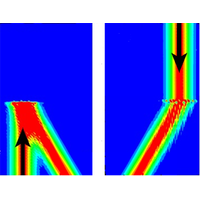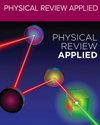弹道石墨烯中电子的非对称传输
IF 4.4
2区 物理与天体物理
Q2 PHYSICS, APPLIED
引用次数: 0
摘要
具有耗尽区的半导体 p-n 结作为一种产生电子不对称传输的传统方法已得到广泛应用。然而,由于单层石墨烯的零带隙特性,这种方法并不适用于单层石墨烯。因此,弹道石墨烯中的非对称传输至今仍难以实现。这里提出了一种基于四层量子点阵列工程的简单方法。尽管该阵列的层数很少,但它具有电子元表面和带隙材料的综合功能,并打破了空间反转的对称性,这些非凡的特性使得电子能够进行非对称传输。我们的研究成果为实现依赖单向效应的电子单元提供了可能,并以近乎完美的效率和简单的设计显示出巨大的应用潜力。本文章由计算机程序翻译,如有差异,请以英文原文为准。

Asymmetric transmission of electrons in ballistic graphene
Semiconductor - junctions with depletion zones have gained widespread use as a conventional way to give rise to electron asymmetric transmission. However, the approach is not applicable to monolayer graphene due to its characteristic feature of zero band gap. Asymmetric transmission in ballistic graphene therefore remains elusive to date. Here a simple approach based on the engineering of a four-layer array of quantum dots is proposed. Despite the array having few layers, it has the combined functionality of electron metasurfaces and band-gap materials with the symmetry breaking of spatial inversion, the extraordinary properties enabling electron asymmetric transmission. Our results open up the possibility of realizing electronic units dependent on the one-way effect and show great application potential with nearly perfect efficiency and simple design.
求助全文
通过发布文献求助,成功后即可免费获取论文全文。
去求助
来源期刊

Physical Review Applied
PHYSICS, APPLIED-
CiteScore
7.80
自引率
8.70%
发文量
760
审稿时长
2.5 months
期刊介绍:
Physical Review Applied (PRApplied) publishes high-quality papers that bridge the gap between engineering and physics, and between current and future technologies. PRApplied welcomes papers from both the engineering and physics communities, in academia and industry.
PRApplied focuses on topics including:
Biophysics, bioelectronics, and biomedical engineering,
Device physics,
Electronics,
Technology to harvest, store, and transmit energy, focusing on renewable energy technologies,
Geophysics and space science,
Industrial physics,
Magnetism and spintronics,
Metamaterials,
Microfluidics,
Nonlinear dynamics and pattern formation in natural or manufactured systems,
Nanoscience and nanotechnology,
Optics, optoelectronics, photonics, and photonic devices,
Quantum information processing, both algorithms and hardware,
Soft matter physics, including granular and complex fluids and active matter.
 求助内容:
求助内容: 应助结果提醒方式:
应助结果提醒方式:


